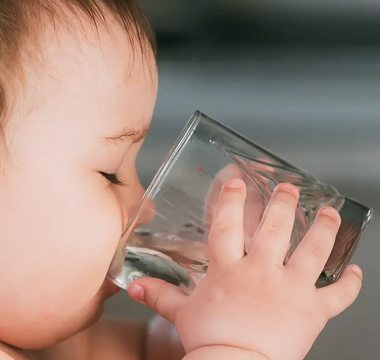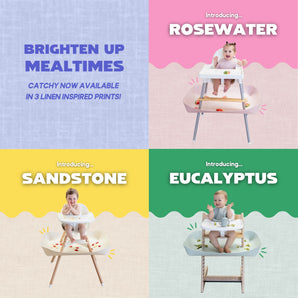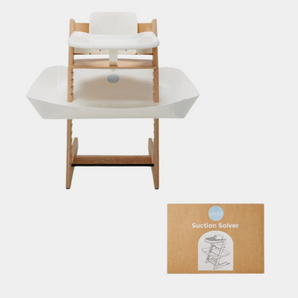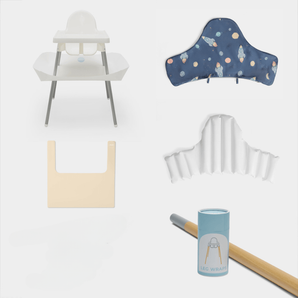Introducing cups can feel overwhelming and time consuming. Fortunately, if you have a plan and consistently stick to it, many babies pick up the skill quickly.
Teaching Baby to Use Cups + Straw Cups
There are really two parts to transitioning to a cup:
-
Drinking skills: how to drink from a cup, including an open cup and straw cup
-
Transitioning from bottles or breastfeeds to solid foods and liquids in a cup (basically eating and drinking like a big kid!)
A small reminder: learning to drink from a cup is a skill, and like all other skills, this will take time and practice to develop. Stay calm, supportive, and patient as your baby learns.
What age should a child drink from an open cup?
You can start introducing your baby to a cup while introducing solids, typically around 6 months old. Your baby should show all the traditional readiness signs for transitioning to solids to start cup drinking practice. If your baby is older than 6 months and taking solids, we recommend you start now. 6- to 12-month-old babies are interested in learning and pick up new table skills quickly, whereas it can be more challenging to introduce these skills to a toddler who is very competent and confident in their skills to drink from a bottle.
The goal in the 6- to 12-month age range is to practice the skills of cup drinking—not to replace the breast or bottle. Starting open cup practice early (ideally around 6 months of age) allows your baby plenty of low-pressure time to hone cup skills before transitioning off bottles or breastfeeds. If you’ve missed this window and your baby is now 12 months or older, all is not lost! Your 12+-month-old still has time to learn this skill!
Which cup should I use for my baby?
There are endless possibilities for cups, but there are only two cups you really need:
-
Open cup
-
Straw cup
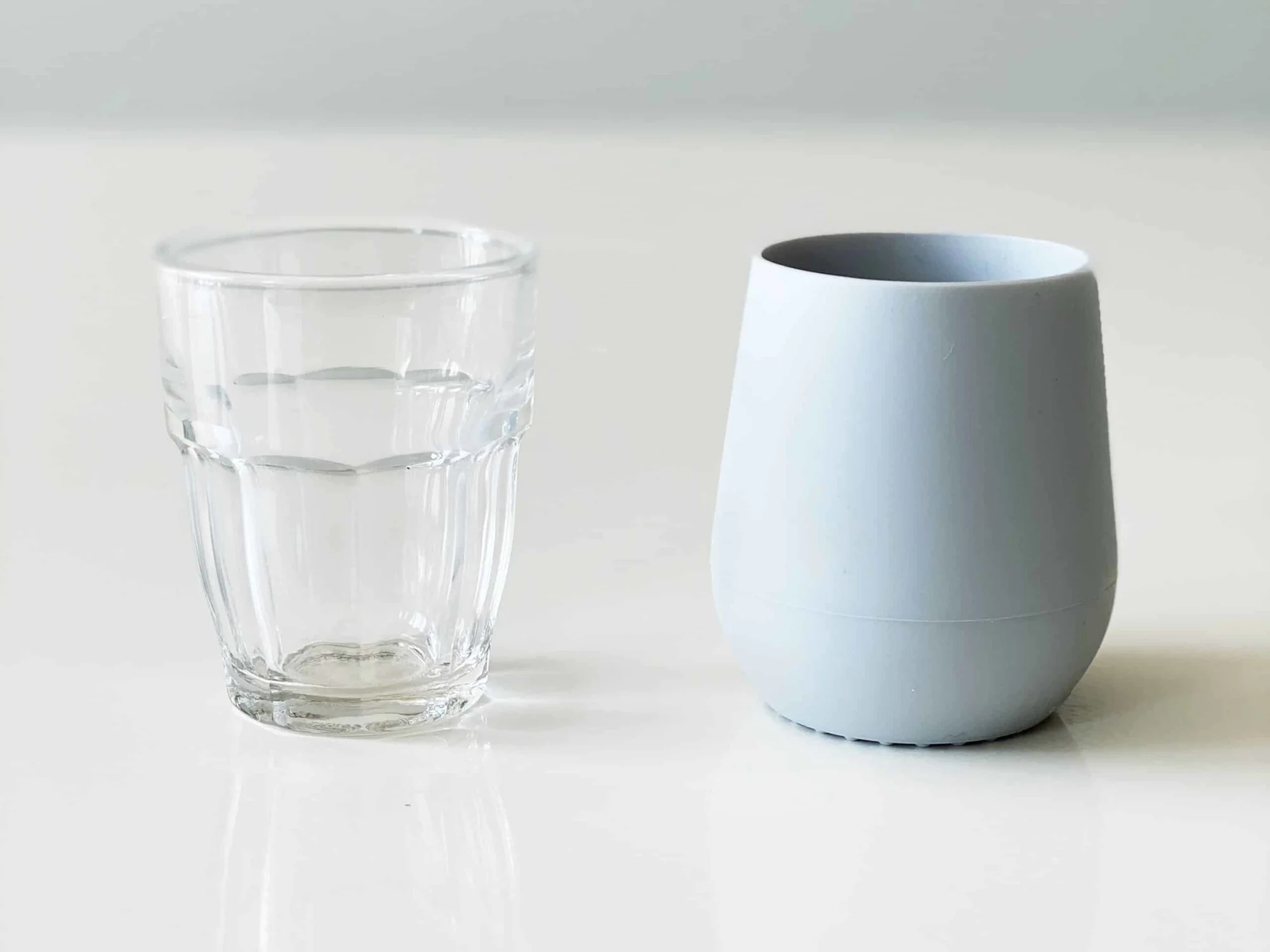
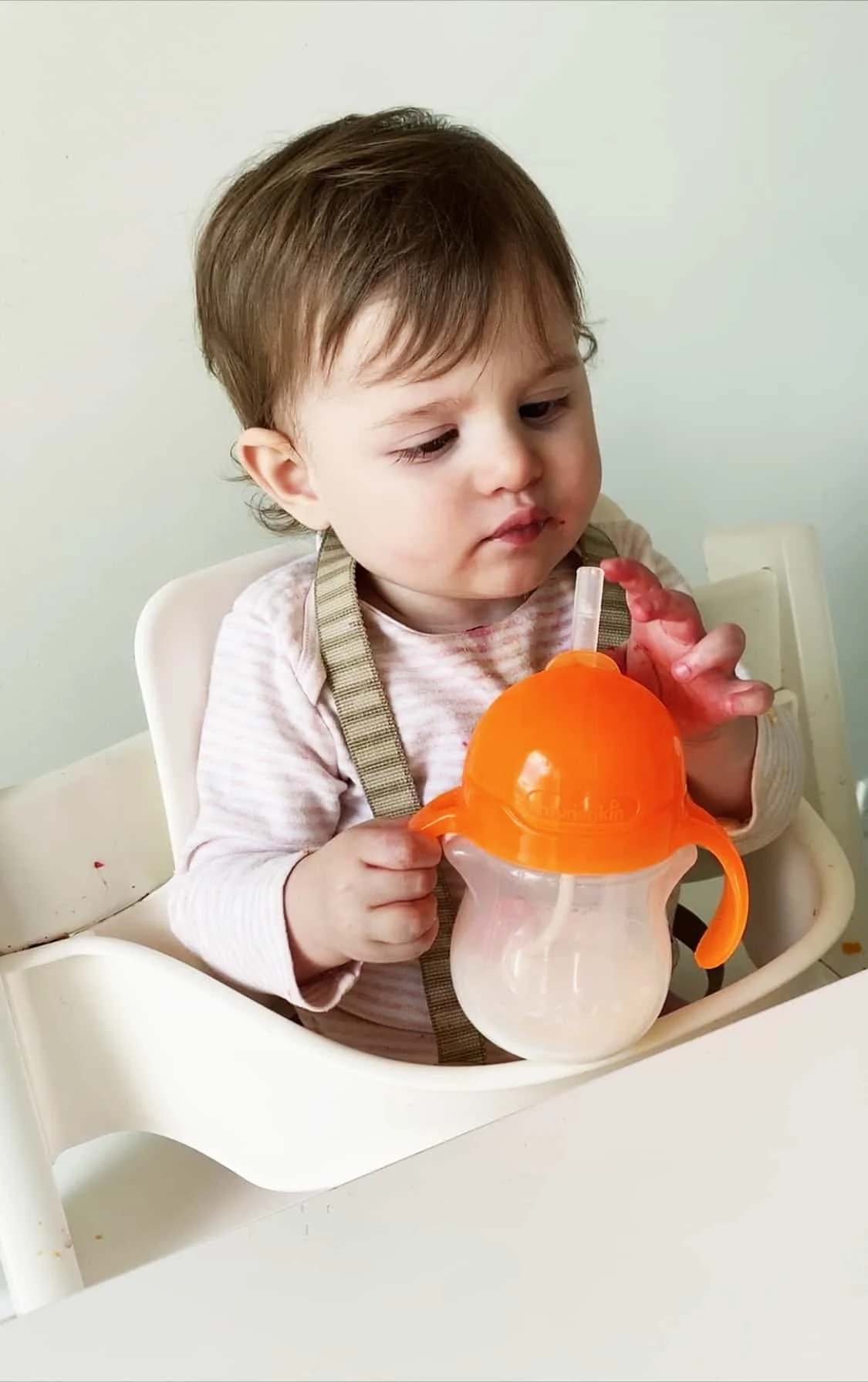
Like most feeding therapists and swallowing specialists, we strongly recommend using open cups and straw cups rather than sippy or 360 cups. Why? Because drinking from an open cup or a straw are lifelong skills—your baby will use both of these skills later on. To the contrary, sippy cups and 360 cups are only for babies/toddlers, so your baby will learn a skill that will be discarded after a few months. Note: If you’ve been using sippy or 360 cups and are now second-guessing yourself, please don’t. Most babies are adaptable and will quickly move on to new skills. They will not be harmed if you continue to use these cups occasionally—more on this below.
Open cup vs. straw cup
Good news! There’s no need to decide between an open cup and straw cup—we recommend introducing both right away. And start with whichever—there’s no right order! While some professionals recommend a particular order, there is no research to support the benefits of introducing an open cup first and then straws or vice versa. If your baby is 6 months old, we recommend starting with both, but at different meals (i.e., an open cup at breakfast and a straw cup at the next meal). If your baby seems to struggle with both skills after a few weeks, choose which cup they like most and stick with it until your baby is doing pretty well, then reintroduce the other.
When choosing an open cup, we recommend using a small cup that’s easy for baby hands to hold. Since you’ll be dealing with many, many spills, look for a cup that holds no more than 1-3 ounces. A small cup also makes it less likely that your baby will flood themselves with liquid. There are many cups on the market that fit this description, but a shot glass or small glass yogurt cup will do just fine, too!
Before choosing a straw cup, we recommend first teaching your baby the skills of using a straw by itself, which we’ll outline below. Once your baby has the basic idea of the straw itself, you can choose any straw cup you prefer, knowing your baby can use it.
For more on cups and straws, watch our video within the Starting Solids course here.
William, 6 months, learns to drink from the ezpz straw cup.
I still need a sippy cup. What’s the best sippy cup for my baby?
There are many sippy cups on the market—soft spouts, firm spouts, with handles, or without handles. But, as feeding specialists, we have to reiterate that we don’t love sippy cups and instead recommend you focus on straw cups when on-the-go or in need of a mess-free meal. Why? Sippy cups encourage your baby to use their tongue in a way that is not ideal for cup or straw drinking. Plus, as soon as your baby masters a sippy cup, it’s time to conquer more mature cup skills, which adds an unnecessary step (and expense) to the process.
Now, before you tear through your kitchen and trash your sippy cups or worry you’ve irreparably damaged your child, we just want to point out that using a sippy cup will not damage your child and likely have zero noticeable impact. In fact, one of our staff feeding therapists occasionally used sippy cups with both of her kids because she already had them and they were spill-proof. While sippy cups may not be ideal for oral motor skill development, babies are incredibly flexible and resilient.
Bottom line: if you’re just starting out, skip the sippy cups. If you’re set on using a sippy cup, we suggest a soft spout over a hard spout because they are more similar to a large straw and might not pin your baby’s tongue down quite as much as a hard spout. And if you’re already using a hard spout sippy cup and your baby loves it, don’t overthink it. Just consider practicing a straw or open cup over the next few months to begin transitioning away from the sippy.
What about cups with handles, or a weighted straw, or a cut-out or angled rim, or…
Completely optional! Some babies take really well to some of these features, but they are totally a personal preference. That said, we strongly recommend against using only one type of cup, especially one with distinct features that aren’t common in adult cups (such as two handles on the sides). Your baby will have to learn to use an open cup without handles or an angled or cut-out rim eventually. We don’t recommend parents seek out these features, but if you are using one of these and your baby likes it, there’s no harm done. Just make sure your baby also gets lots of exposure to other types of cups along the way.
How to teach baby to drink from an open cup
Step 1: Put a small amount of breast milk, formula, or water* (1-2 oz at most) in a cup. Show your baby how it’s done by bringing the open cup to the table at mealtime with 1-2 oz of breast milk, formula, or water in it.
Step 2: Sit down, smile at your baby to catch their attention, and then bring the cup to your mouth to take a small sip. (You can use the same cup if you are comfortable with that or two cups, one for you and one for baby. Just make sure you are drinking out of the same looking cup.)
Step 3: Offer the cup to your baby, holding it in front of them and letting your baby reach out. Don’t bring it to their lips right away. Allow them to reach out and grab it, and then assist in getting it to their mouth.
Amelia, 7 months, reaches for her cup and drink water.
Amelia, one month later at 8 months, uses her cup independently.
The overall idea is to have your baby actively engaged, rather than sitting back while you pour liquid into their open mouth. You can help your baby stabilize the cup on their lower lip and tilt it just enough to bring the liquid into their mouth. You might see your baby lick the liquid, spill it, or even cough and sputter a bit. This is normal. As your baby learns, there will be many mistakes before they get it right.
If your baby is very set on holding the cup alone, you can set it down and let your baby try independently. Just be ready with a napkin when your baby inevitably tilts the cup back too far and pours water all over themselves! When this happens, just say, “Oops! Slower next time.” You can add a tiny bit more water and let your baby try again. If it spills again, no need to refill at that meal; just set the cup aside and wait until the next meal. Continue to introduce the cup in this way at each meal (or at least daily) to help your baby learn. You may find that your baby does best if you offer the cup after eating a bit or possibly the opposite—that your baby needs to practice with the cup first and then wants to eat solids. There isn’t one right way to do it. Watch for and respond to your baby’s cues and preferences.
As your baby gets more coordinated, you can start to set the open cup on the table at meals and allow your baby to pick it up and drink independently. If your baby playfully dumps the contents, do not replace it at that meal and calmly let them know, “Uh-oh! Your water is all gone now.” Of course, if your baby accidentally spilled their cup, use your judgment about offering more—just avoid starting a game of “I spill my cup and my parent fills it back up!”
*Before 12 months old, we do not want a baby to fill up on water instead of more nutritious formula or breast milk. Therefore, if you are using water for cup practice, we recommend a very small amount of water (1-2 oz at most) solely for practicing the skills of cup drinking.
How to teach baby to drink from a straw
You can teach your baby to drink from a straw starting at 6 months old. You might be surprised to find that your baby “gets it” immediately. This is common because 6-month-olds have a strong sucking reflex and can use that pattern successfully on a straw. Thus, some parents find more success with getting straw drinking up and running first, then introducing the open cup.
If your baby does not immediately catch on to the straw, or if you’re introducing the straw to a baby who is 8 months or older, you may need to teach them to close their lips and suck. There are two main ways to teach this, which we'll outline below.
Pipette method
Step 1: Using a straw (a standard plastic restaurant straw will do), use your finger to trap a *small* amount of liquid in the bottom.
Step 2: Hold it out towards your baby and wait for your baby to open their mouth to accept it.
Step 3: When baby accepts the straw in their mouth, take your finger off the top and allow the liquid to pour into their mouth. This usually helps your baby understand to close their lips, and that liquid comes out of the straw.
Practice this a few times as long as your baby is interested, put the straw back into the cup, and offer it to your baby. If your baby pushes it away or just wants to grab and play with the straw, tell them you’ll try again later and put the straw away until the next meal. Usually, within a few tries, your baby will figure out how to use the straw.
Kary Rappaport, a Solid Starts feeding specialist, teaches her daughter Lucy, 7 months, how to drink from a straw with the pipette method.
Straw trainer method
There are a few cups out there that actually help bring the liquid up the straw. The "Mr. Juice Bear" therapy cup, or honey bear cup is made just to teach straw drinking. Although not made for this purpose, the take and toss straw cup has similar functionality and is less expensive. These cups have a very short shelf life because your baby basically outgrows it as soon as it does its job—which is to teach your baby how to drink from a straw! (Babies will also catch on that they can squeeze it and use it like a fire hose!) However, we mention it because it’s really effective for babies who are struggling with the straw. If this is your baby and the pipette method did not work, here’s how you can employ straw trainer cups like Mr. Juice Bear or a take and toss straw cup:
Step 1: Bring the straw trainer with water, breast milk, or formula to the table and offer the straw to your baby by holding it in front of their mouth. Often babies who may have already decided that they hate straw cups will happily accept this cute little bear! The take and toss cups are brightly colored and fun as well.
Step 2: Let your baby open their mouth and lean in to accept the straw, then give a little squeeze to the cup, which will express a small amount of the liquid into your baby’s mouth. Most babies will respond by immediately sealing their lips to swallow, which helps them learn to close their lips around the straw.
After practicing like this several times, you can offer the straw trainer to your baby but do not squeeze. Wait and see if they try to get the liquid out on their own by sucking. It may take several introductions, but once they understand how to consistently use the straw and no longer need the squeeze feature, you can transition to other straw cups to generalize the skill to all straws.
Caden, 8 months, learns to drink from his honey bear straw trainer cup.
What if baby sucks from the straw but then spits or lets the water fall out of their mouth?
If baby is successfully using the straw, but then letting the liquid come back out of their mouth, there are a few things you can try.
-
Use a straw that provides a little more resistance and a slower flow so baby has to "work" at it a bit more. Ideally, this encourages baby to close their lips more forcefully around the straw, thus helping keep the liquid inside the mouth. The Munchkin weighted straw cup is a good one for this kind of practice (our product suggestions are never sponsored).
-
Try using a very skinny straw to encourage baby to keep their lips sealed tight around the straw (such as a coffee stirrer).
-
For toddlers 12 months+, you can practice drinking thicker liquids through a straw, such as kefir, smoothies, etc. Because they are thicker, these liquids tend to move more slowly, giving the child's brain more time to understand where the liquid is moving in the mouth.
What to do if baby is resistant or struggling with cup drinking
Baby not interested in cup drinking
Wait it out. If your baby is 6-8 months old and not interested in cup drinking, but otherwise interested in food and not upset by the cup, simply bring the cup to each meal and show your baby how it’s done. Give your baby time to show interest and try on their own.
Chase the why. If your baby is older than 8 months and/or starting to show outright refusal or frustration, continue to stay calm and unruffled. Take a minute to ask yourself, “why?” Does your baby want to do it independently and you’re trying to help? Is your baby just completely baffled about what to do with the cup or straw? Allow your answer to guide your support. For example, if your baby is independent, you may need to be hands-off, even if that means your baby spills water over and over again. Put only a small amount in the cup, bring a towel to the table, and remain calm. Modify the recommendations above based on what you suspect might be contributing to the refusal.
Hunger can be motivating. Make sure your baby has at least a bit of hunger motivation at the meal by separating out breast or bottle-feeds from table feeds by at least 60 minutes. If your baby is 9+ months old, you may separate them even more (by 2-3 hours) to see if this helps.
Be the example. Model the behavior by drinking from the same cup at mealtimes and occasionally offering the cup to your baby by holding it out to them after you take a drink. Stay calm and confident that your baby will learn this with time. Try water at some meals and breast milk or formula at other meals to see if one of the flavors is more enticing. If your baby is struggling, stick with one type of cup for several days or weeks at a time, rather than switching back and forth between straw and open cups. However, if you find your baby crying at the sight of the cup or immediately arching and pushing the cup away, take a break for a few days, then try again with a different type of cup.
Change the environment. If a baby is actively refusing to try drinking with a straw cup or open cup at meals, try changing the environment. Outside of a meal, prepare an open cup or straw cup with water. Pick up your baby and interact for a moment, capturing their attention, then casually walk over to the cup, pick it up, and start drinking. After a few sips, smile big at your baby and make a funny noise or silly face to further engage your baby. Do not offer the cup at first. Continue this for a minute or so until your baby tries to reach out and grab your cup; if this doesn’t happen, hold the cup close to your baby and wait for them to lean forward, put their mouth on it, or reach out for it. If so, help them take a drink or hand them the cup and let them try it. Often, babies are much more open to trying a cup outside of the normal mealtime environment.
Get messy. Lastly, try sitting on a blanket outside or somewhere you won’t mind spills. Bring a few cups and a small pitcher of water or water bottle to the blanket and set them in front of your baby. If they don’t naturally engage, pick up the pitcher or water bottle and show your baby how to pour the water into a cup and take a drink. Then, sit back and let your baby try. As we mentioned above, often this low-pressure type of play will cause the most resistant babies to engage, and once they are happily playing, they are more likely to imitate you and try drinking from the cup.
Baby pours the cup all over themselves and/or coughs or chokes frequently
If your baby frequently spills, coughs, and/or chokes on the liquid because they are pouring it too fast, first try offering a much smaller amount in the cup (like ½ oz). You want just enough that if they pour it all in their mouth, it won’t overwhelm them! If your baby is already too upset and refuses the open cup, try a straw cup for a while, then try again with the open cup in a few days or week. If this still does not solve your issue, try a small amount of a thicker texture (such as a stage one puree, smoothie, or kefir) in the cup to slow down the flow. This can improve your baby’s chances of success and encourage your baby to stick with it and build their skills.
Max, 15 months, takes too big of a drink from his milk. An ideal cup would be one that is a bit smaller. Cups with handles can actually make it harder to control the tipping motion babies need to get the milk to flow slowly from the cup.
Adie, 15 months, drinks from an open cup independently. Small cups with no handles will often help babies and toddlers control the flow of the milk more effectively.
Baby's lips won't close around straw
If you have tried the pipette method and the honey bear method and your baby still won't close their lips around the straw, try modeling "fish lips" and a sucking sound yourself. Drink from the straw yourself, show the "fish lips" afterwards, and then hand the straw cup to your baby.
Adie, 11 months, practices her straw cup, trying to figure it out.
Solid Starts founder Jenny Best demonstrates how to coach a baby to seal their lips around a straw by modeling "fish lips".
Adie, 11 months, practices fish lips.
Baby only bites the straw
Biting the straw is a very developmentally normal response! They are seeking jaw stability. As a caregiver, we recommend talking to them, showing them how to bite softly on foods without leaving teeth tracks, show them how you bite on the straw then let go and just use lips. Use a firm straw that won’t collapse. We would also recommend practicing with the pipette method so they feel liquid coming out of the straw.
Baby won’t hold their cup
If your baby won’t hold the cup without your help or only wants you to do it, encourage your baby to join in by holding the cup in front of them and wait. When your baby leans in and puts their mouth on the cup, use one of your hands to guide their hands onto the cup, then help tilt the cup. After practicing like this for several days, your baby should begin reaching for the cup as you introduce it. Once your baby starts to do this, remove your hands so your baby is holding the cup alone. You should be able to progress from here to just handing your baby the cup and then setting the cup down on the table so your baby has to pick it up independently.
Ripley, 9 months, drinks from an open cup that mom controls. While less messy, when parents fully control the cup, babies learn they need not (or should not) reach for it, which can prolong the learning process and delay independent cup use.
Quentin, 8 months, reaches for his cup. Giving your baby the chance to reach for the cup before you bring it to their mouth will speed the learning process for independent cup drinking.
Baby putting food in cup/splashing
This is a normal form of exploration for babies and toddlers, and it’s great for children to explore different textures. On the other hand, it can be distracting and quite messy. If you want to decrease this behavior at the table, try to offer opportunities for this exploration outside of meal times: finding items while outside and putting them in a bucket of water, or playing with squishy toys and cups in the bathtub. At the table, you might consider taking a break from an open cup for a few days and only offering a straw cup with meals. This can break the association for a bit and help reset use of the open cup. Ideally, when you reintroduce the open cup and model how to use it, your child may be more interested in learning how to use it as you are.
Five tips for helping toddlers drink water (12 months+)
-
Let your toddler pick a special water bottle that they get to fill up each morning. Take a special trip to the store and make it a big deal for them to choose their new bottle.
-
Make it a habit explicitly, so they learn to drink on their own. When out and about, both of you take five sips of water every hour. Do it as a team, make it fun (count out loud, make up a song, etc.)
-
Have water available with every meal and snack.
-
Make the water more fun and interesting. Add sliced fruit or cucumbers.
-
Last resort: use a sticker or reward system for finishing a water bottle. Do not reward with food! Reward with fun activities like extra time at the park, or a family movie, etc.
When will my child be able to use their cup independently?
While there is a broad range for when a child will achieve this skill, the American Academy of Pediatrics' Ages and Stages Questionnaire classifies independent cup drinking with minimal spillage as an 18-24 month skill. Expect occasional small spills even through 3 years old, which should further improve as your child's graded fine motor control and focus improve. That said, many children can independently use a spill-proof straw cup much earlier than this, closer to 12-18 months old if they started practicing at 6 months.
When to seek help
If you've been trying for quite some time or if it seems something is just off, it's time to talk to your pediatrician or health professional. Definitely consult your doctor if:
-
You and your baby have been trying with cups for several months without success
-
Your baby is not maintaining their weight when you reduce breast or bottle-feeds
-
Your baby is not increasing solid food intake or not taking water or milk in a cup despite reducing breast or bottle-feeds
-
Your child is older than 15 months
We recommend you seek support from an occupational therapist or speech therapist who has a specialty in feeding, eating, and swallowing to help your baby learn this skill.
Patience and practice
Learning to drink from a cup takes a lot of practice and a lot of repetition. Start early (6 months) if you can so you have a long, stress-free runway for your baby to get the skill down pat. While it may take several months to master, you’ll be saying “cheers” with your cups soon enough.
Ripley, 9 months, explores her open cup. Letting baby touch, bite, and explore their cup (with or without liquid) is an important part of learning to use the cup.


